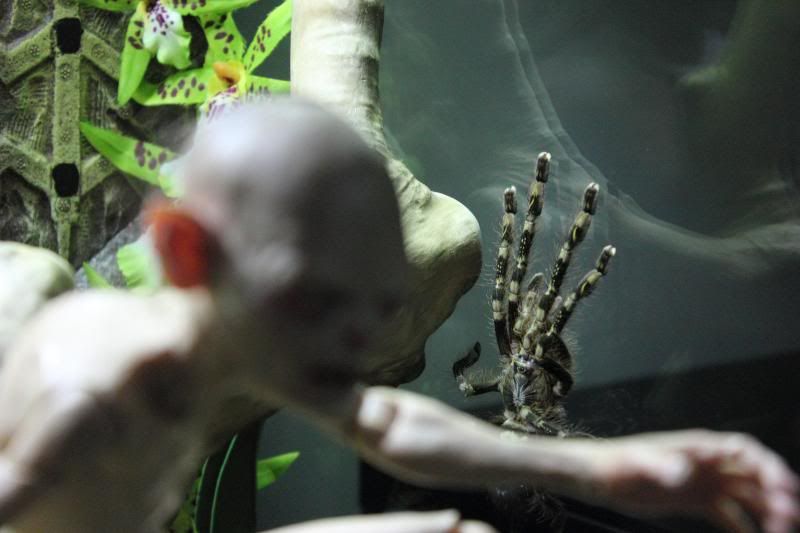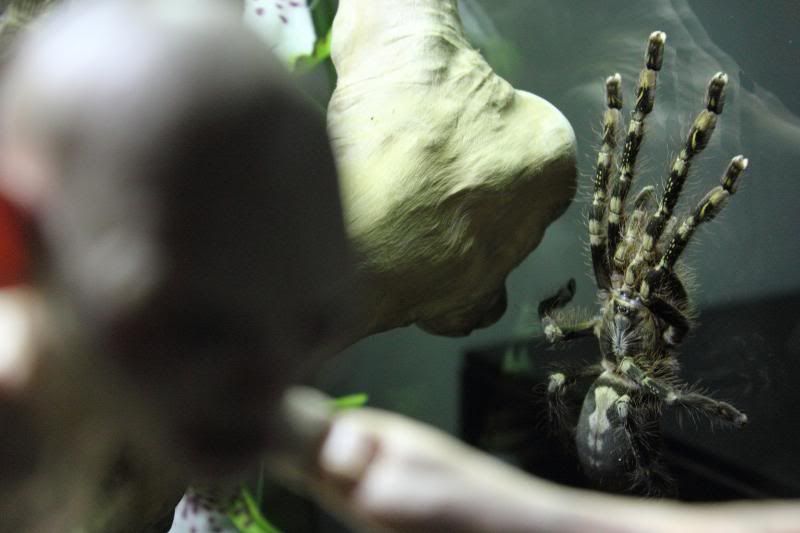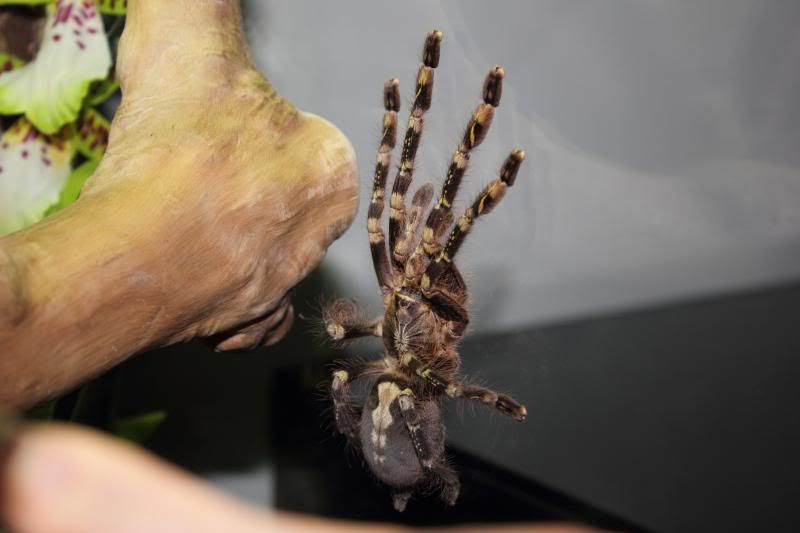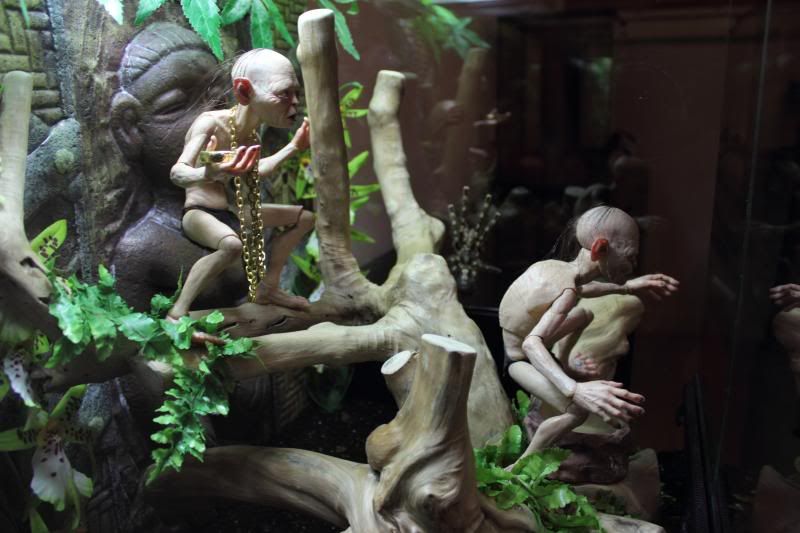p.subfusca highland and lowland
- Thread starter karambola
- Start date
LordWaffle
Arachnobaron
- Joined
- Nov 20, 2013
- Messages
- 449
Highland. It's my favorite Pokie 
Bipolar Spider
Arachnopeon
- Joined
- Jul 18, 2013
- Messages
- 46
Lowland (bara) is the darker one
Poecilotheria Subfusca C&P
These spiders have been subject to some controversy in recent years. Colouration and patterning in P. Subfusca can vary from specimen to specimen quite dramatically. Some dealers have been advertising and selling "highland" and "lowland" forms of P. Subfusca, with the "lowland" form usually demanding more money. However several reputable breeders have gone on record to say that they have observed both forms coming from the same sac. It has been theorised that the temperature the egg is incubated at determines the colouration. I hope to test this theory out myself over the coming year. As such, if you do buy a P. Subfusca, try not to pay over the odds for "lowland" specimens seeing as it is possibly just a P. Subfusca that has been incubated at a higher temperature. Ventral markings on both highland and lowland P. Subfusca are identical, and as such should be considered the same spider, even though dorsal markings can differ. Colouration seems to be based on regional distribution.
My LL in premolt (her abdomen actually got lighter while in premolt) black as night now




Poecilotheria Subfusca C&P
These spiders have been subject to some controversy in recent years. Colouration and patterning in P. Subfusca can vary from specimen to specimen quite dramatically. Some dealers have been advertising and selling "highland" and "lowland" forms of P. Subfusca, with the "lowland" form usually demanding more money. However several reputable breeders have gone on record to say that they have observed both forms coming from the same sac. It has been theorised that the temperature the egg is incubated at determines the colouration. I hope to test this theory out myself over the coming year. As such, if you do buy a P. Subfusca, try not to pay over the odds for "lowland" specimens seeing as it is possibly just a P. Subfusca that has been incubated at a higher temperature. Ventral markings on both highland and lowland P. Subfusca are identical, and as such should be considered the same spider, even though dorsal markings can differ. Colouration seems to be based on regional distribution.
My LL in premolt (her abdomen actually got lighter while in premolt) black as night now




Last edited:
- Joined
- Aug 12, 2007
- Messages
- 1,749
We wants it, we needs it. Must have the precious.
Bipolar Spider
Arachnopeon
- Joined
- Jul 18, 2013
- Messages
- 46
Last edited:
- Joined
- Mar 25, 2007
- Messages
- 911
Poecilotheria subfusca"Highland" = Very dark Carapace with pointed star around the fovea. Whole folio on the abdomen, and are 15-16 cm in legspan.
As juveniles, they are very easy to see gender differences. Women have large white markings between the patella
and femur, males have only two small bright lines on the patella.
Poecilotheria subfusca "Lowland" = Light gray / brown Carapace with unclear star around the fovea. Distributed folio on the abdomen and is
18-20 cm in legspan. You cannot see the gender differences between P. sp. "Lowland", just by looking at the patella and femur.
The differences are best seen in mature individuals, many images on the Internet shows subadult individuals that do not show the
correct and clear differences between P. subfusca "Highland" and P. subfusca "Lowland".
As juveniles, they are very easy to see gender differences. Women have large white markings between the patella
and femur, males have only two small bright lines on the patella.
Poecilotheria subfusca "Lowland" = Light gray / brown Carapace with unclear star around the fovea. Distributed folio on the abdomen and is
18-20 cm in legspan. You cannot see the gender differences between P. sp. "Lowland", just by looking at the patella and femur.
The differences are best seen in mature individuals, many images on the Internet shows subadult individuals that do not show the
correct and clear differences between P. subfusca "Highland" and P. subfusca "Lowland".
Poec54
Arachnoemperor
- Joined
- Mar 26, 2013
- Messages
- 4,742
+1. The high elevation form is the dark one, and lives at 6,000+ near Nuwara Elyia. Adaptations to that elevation include a smaller size and more black on it, to absorb sunlight to warm up.Highland.
The 'lowland' form is actually mid-elevation near Kandy, and lives where temps are close to Florida, so they're much more heat tolerant. They have much more gold on the carapace and legs, and the folium isn't as dark.
Both occur in the high-rainfall mountains in the center of Sri Lanka, and appreciate more humid conditions than other Poec species (while still needing ample ventilation).
There's a lot of confusion as to their identity (in continential Europe, the name 'bara' is still commonly used). Both forms are commonly mislabeled in the trade, maybe more often than they're correctly labeled. No doubt the two forms are regularly mated together and mixed offspring distributed throughout the hobby.
- Joined
- Oct 5, 2012
- Messages
- 411
So as a European, my best bet is to actually pick a rufilata or ornata instead, because who knows what I'd get as "bara" or "subfusca" ?
Poec54
Arachnoemperor
- Joined
- Mar 26, 2013
- Messages
- 4,742
Actually, the spiders in Europe are probably labeled more accurately, as many of them have kept the 'bara' distinction. I think when the two were lumped together as a single species, the the problems in the US increased. It's confused many people here, and some of them assume that 'if they're both the same species, it doesn't matter if you pair up highland and lowland.' If they were still considered two separate species, Americans would have been more careful about knowing what they had and what they paired up.So as a European, my best bet is to actually pick a rufilata or ornata instead, because who knows what I'd get as "bara" or "subfusca" ?
- Joined
- Jan 30, 2012
- Messages
- 3,794
I can tell you right away that a certain breeder (MS) sells the correct spiders. I got my "lowland" (I'm not going to use "bara" as it's a junior synonym not anymore in use) from him, raised him to MM, then gave him to a friend of mine in exchange for slingsSo as a European, my best bet is to actually pick a rufilata or ornata instead, because who knows what I'd get as "bara" or "subfusca" ?
Personally, I favorize the "lowland" - argueably more beautiful than P. metallica in my personal opinion
- Joined
- Oct 5, 2012
- Messages
- 411
I favor the darker carapace form, aka highland (unless I get that messed up), guess it must be due to advan's black and gold monster 
- Joined
- Jan 4, 2003
- Messages
- 2,721
It depends who you ask, that's the problem. See the responses.which is the dark subfusca the highland or the lowland?
Later, Tom
- Joined
- Oct 5, 2012
- Messages
- 411
I've encountered the same problem when I asked around at the expos. No answer was actually the same.It depends who you ask, that's the problem. See the responses.
Later, Tom
TLover007
Arachnosquire
- Joined
- Feb 23, 2014
- Messages
- 143
Poec54
Arachnoemperor
- Joined
- Mar 26, 2013
- Messages
- 4,742
Yes, a lot of gold on the carapace, more prominent gold banding on the legs, and a light-colored folium.Personally I love the lowland... im now in search for a few slings here they are just the most beautifull thing I have ever seen... i found this pic and if im correct its the lowland.
TLover007
Arachnosquire
- Joined
- Feb 23, 2014
- Messages
- 143
Again personally... thats more beautifull than an P Metallica to me
Im crazy... and I Love Ts!!!!
Im crazy... and I Love Ts!!!!
TLover007
Arachnosquire
- Joined
- Feb 23, 2014
- Messages
- 143
Just ordered my first subfusca lowland yyyyeeeeaaahhhh!!!! 


Im crazy... and I Love Ts!!!!
Im crazy... and I Love Ts!!!!

